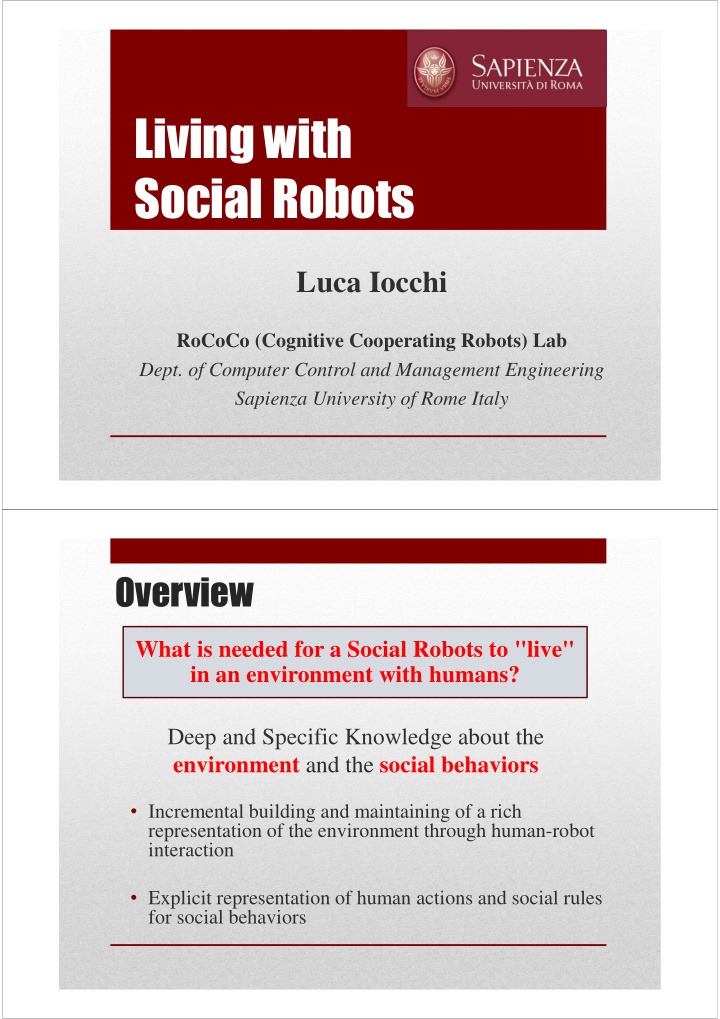



Living with Social Robots Luca Iocchi RoCoCo (Cognitive Cooperating Robots) Lab Dept. of Computer Control and Management Engineering Sapienza University of Rome Italy Overview What is needed for a Social Robots to "live" in an environment with humans? Deep and Specific Knowledge about the environment and the social behaviors • Incremental building and maintaining of a rich representation of the environment through human-robot interaction • Explicit representation of human actions and social rules for social behaviors
Motivations Rich representation of the environment through human-robot interaction Robot perception still very limited to capture specific knowledge about an environment Explicit representation of social action and rules Hand-coded social behaviors limit scalability to complex situations Summary 1. Interactive Incremental knowledge acquisition 2. Explicit representation of social rules and actions
Interactive Knowledge Acquisition [ICAR13, ISER14] Acquisition of semantic information about the environment through on-board sensors and HRI System architecture
Example [ICAR13] On-line semantic mapping KB representation • Concept Taxonomy • Instance Signatures • Semantic Grid Map • Topological Graph
Multi-modal knowledge acquisition [ISR13] • Spoken dialogue • Laser pointer • Visual object detection and recognition Speech Recognition [AGI13] • Grammar-based ASR (Microsoft engine) • Semantic output ( frame ) for each rule • Structured commands for the robot • Grammars loaded on-line based on context [ Go ] Motion [near the chair] Goal [slowly] Manner
Petri Net Plans [JAAMAS11] Formal model for representation and execution of complex (multi-)robot plans. Petri Net Plans execution Complex interactions modelled with PNP
Object Detection from RGBD KB reasoning
KB reasoning [VIDEO] Sockets Use cases Multiple robots, multiple environments, multiple users
Some results Correct positioning of semantic elements in the map by users using the system Summary 1. Interactive Incremental knowledge acquisition 2. Explicit representation of social rules and actions
Explicit Representation of KB KB models: • Domain description • Robot actions • Human actions • Social rules Classic Plan-Execution Framework
Social Plan-Execution Framework [ICSR14, IROS2015] Answer Set Programming ASP Modelling and Reasoning • common-sense knowledge • domain knowledge • social rules • human and robot actions Explicit representation vs. implicit (hand-coded) definitions
Use case � Deliver papers printed by a printer to a location that is behind a closed door. � Robot cannot take papers or open doors � Users are not aware of the robot’s plan Example: opening a door
HR-PNP to executable PNP Human action is transformed in a PNP sub-plan Executable PNP Complex behavior integrating robot actions and human interactions
Video Executing the social task Results 70 runs with different combinations of social norms Successful execution of the task with human help 42 % Unsuccessful execution of the task but user was 6% willing to help User answered that s/he was not willing to help 10% No answer to robot’s request 42%
Recommend
More recommend